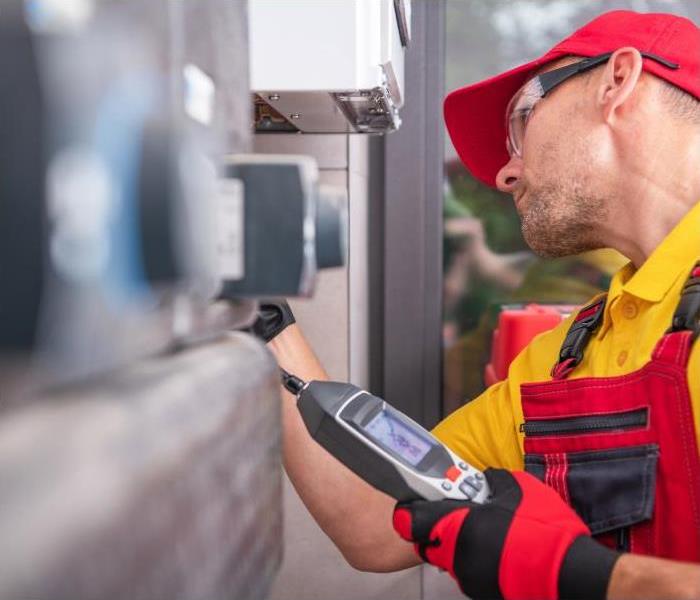4 Steps of Action To Take After Storm Damage in West Valley City, UT
9/2/2024 (Permalink)
Storms can be both unpredictable and devastating. When a severe storm strikes West Valley City, UT, the aftermath can leave homes and properties in disarray. Acting promptly and effectively is crucial to mitigate further damage and begin the restoration process. Here are four essential steps to take after experiencing storm damage in West Valley City to ensure a thorough and efficient recovery.
1. Ensure Safety and Assess the Situation
Prioritize Safety
The first and most important step is ensuring the safety of everyone on the property. After a storm, there may be hazards such as fallen power lines, unstable structures, or gas leaks. Before entering your home or any damaged areas, take these precautions:
Check for Gas Leaks: If you smell gas or suspect a leak, evacuate immediately and contact your utility provider.
Avoid Electrical Hazards: Stay away from any exposed electrical wires and avoid touching anything electrical if you're wet or standing in water.
Assess Structural Integrity: Look for signs of severe structural damage, such as large cracks in walls or sagging roofs. If there is significant damage, it is best to have a professional assess the safety of the building before re-entering.
Document the Damage
Once it is safe to do so, begin documenting the extent of the damage for insurance purposes. Take clear photographs or videos of all affected areas and items. This documentation will be crucial when filing an insurance claim and will help restoration professionals understand the full scope of the damage.
2. Contact Your Insurance Provider
Report the Damage
Reach out to your insurance provider as soon as possible to report the storm damage. Provide them with detailed information about the extent of the damage and share the documentation you collected. Your insurance company will guide you through the claims process and advise you on any immediate steps you need to take.
Understand Your Coverage
Review your insurance policy to understand what is covered under storm damage and any deductibles or limits that may apply. This will help you set realistic expectations for the claims process and determine what costs you might need to cover out of pocket.
Schedule an Inspection
Arrange for an insurance adjuster to inspect the damage. They will assess the situation, verify the extent of the damage, and determine the amount of coverage you are eligible for. Having a clear and accurate report from the adjuster will facilitate the repair and restoration process.
3. Begin the Cleanup Process
Remove Standing Water
If your home has experienced flooding or water damage, it is crucial to remove standing water as quickly as possible to prevent mold growth and further structural damage. Use a wet/dry vacuum or a sump pump to extract water from the affected areas. If the water is extensive or involves contaminated sources, it is advisable to hire a professional water damage restoration service.
Dry Out the Affected Areas
After removing standing water, thoroughly dry out the affected areas. Use fans, dehumidifiers, and open windows to promote airflow and reduce moisture. This step is essential to prevent mold growth and further deterioration of building materials. If you notice any signs of mold growth, such as a musty odor or visible mold, contact a professional mold remediation service.
Remove Damaged Materials
Carefully remove any damaged materials that cannot be salvaged, such as soaked insulation, drywall, or flooring. Be cautious when handling these materials, as they may be contaminated with bacteria or other harmful substances. Proper disposal of these materials is important to ensure a safe and clean environment for restoration.
4. Begin Repairs and Restoration
Hire a Professional Restoration Service
Once the initial cleanup is complete, it is time to begin repairs and restoration. Hiring a professional restoration service, like SERVPRO®, can ensure that the repairs are done correctly and efficiently. Restoration experts will have the necessary equipment and expertise to handle complex repairs and restore your property to its pre-damage condition.
Prioritize Repairs
Start with critical repairs that address structural issues or prevent further damage. This may include repairing roofs, windows, or doors that were damaged during the storm. Addressing these issues promptly will help protect your home from additional weather-related damage and ensure the safety and integrity of the structure.
Work with Your Insurance Company
Coordinate with your insurance company and restoration service to ensure that all necessary repairs are covered by your policy. Keep detailed records of all repair work, including invoices and receipts, to provide to your insurance provider for reimbursement.
Recovering from storm damage in West Valley City, UT, requires prompt action and careful planning. By following these four steps—ensuring safety, contacting your insurance provider, beginning the cleanup process, and starting repairs—you can effectively manage the aftermath of a storm and restore your home to its original condition. Remember, the expertise of professional restoration services, such as SERVPRO®, can make a significant difference in the speed and quality of the restoration process. If you need assistance with storm damage restoration, don’t hesitate to reach out to our team for support and guidance.






 24/7 Emergency Service
24/7 Emergency Service
